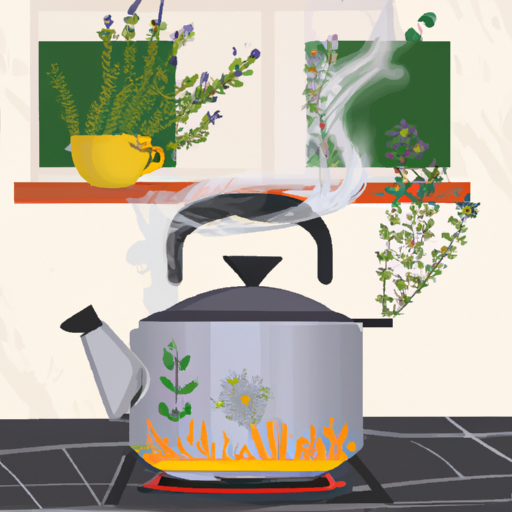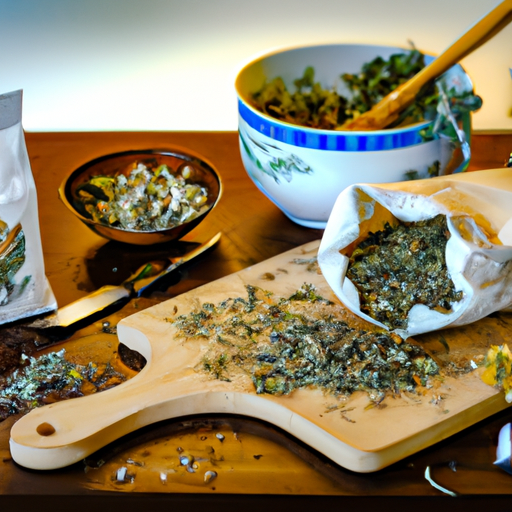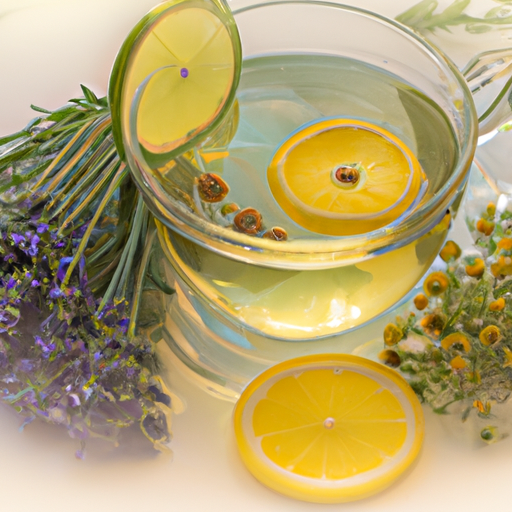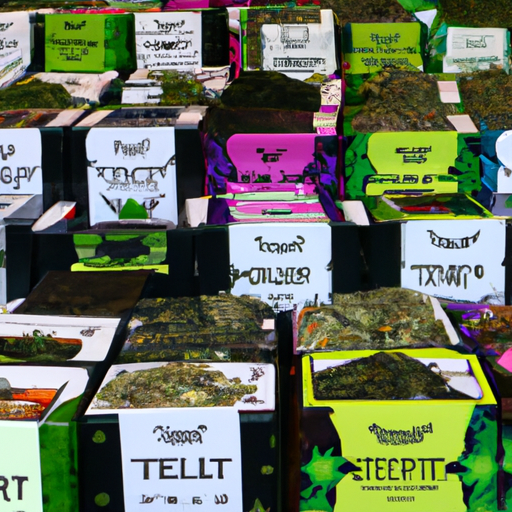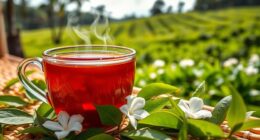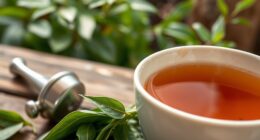Find solace in the soothing essence of nature’s healing touch with the centuries-old remedy of herbal tea for cough. Imagine yourself in a serene setting, cozy and warm, holding a cup of fragrant brew in your hands.
As the delicate vapors rise and dance, soothing warmth envelopes your senses, drawing you deeper into a state of tranquility. This ancient tradition, passed down through generations, harnesses the restorative properties of carefully selected herbs to provide relief from the persistent, nagging cough that plagues us all.
With a few simple steps, you can unlock the secrets of this time-honored elixir. Join me on this journey as we uncover the art of crafting herbal tea for cough – a natural remedy that not only heals the body, but also nourishes the soul.
Let us delve into the world of herbs, ingredients, and brewing techniques, and discover the serenity and wellness that awaits within each cup.
Key Takeaways
- Licorice root and thyme are effective herbs for providing relief from cough and cold symptoms.
- Peppermint and eucalyptus help clear congestion and promote easier breathing during cough.
- Using organic herbs ensures purity and effectiveness in herbal tea for cough.
- Following specific brewing methods and instructions for each herb is crucial for desired potency and healing benefits of herbal tea.
Choose the Right Herbs for Cough Relief
Now, you need to choose the right herbs that’ll bring soothing relief to your cough. Herbal tea blends for respiratory health are a wonderful way to find comfort from cough and cold symptoms.
Nature has provided us with a multitude of natural remedies for cough and cold, and incorporating them into a warm cup of herbal tea can provide great relief. Look for herbs like licorice root, which has been used for centuries to calm irritated throats, or thyme, which has powerful antiviral properties. Peppermint and eucalyptus are also excellent choices for their ability to clear congestion and promote easier breathing.
These herbs, combined in a carefully crafted blend, will provide the perfect cup of tea to alleviate your cough and cold symptoms.
Now, let’s move on to gathering the ingredients for your healing tea.
Gather the Ingredients
In order to make herbal tea for cough relief, I recommend starting by purchasing or harvesting the necessary herbs. This will ensure that you have the freshest ingredients to make the most effective tea.
Additionally, it’s important to gather all the tools and equipment needed for brewing the tea, such as a teapot, teacups, and a strainer. By being prepared with the ingredients and equipment, you can create a holistic, natural, and traditional remedy to soothe your cough.
Purchase or harvest the necessary herbs
First, gather the herbs you need for your herbal tea to soothe that pesky cough. When it comes to harvesting herbs, you can either buy them from a trusted source or harvest them yourself. If you’re buying, make sure to choose organic herbs to ensure their purity and effectiveness. Look for herbs like licorice root, ginger, peppermint, and thyme, as they’re known for their soothing properties.
If you prefer to harvest your own herbs, make sure you do so from a clean and pesticide-free environment. Take care to properly identify the herbs and gather them at the right time for maximum potency.
Once you have gathered the necessary herbs, make sure to transition into the next section by ensuring you have all the tools and equipment needed for brewing herbal tea.
Ensure you have all the tools and equipment needed for brewing herbal tea
To brew a delicious and soothing cup of herbal tea, it’s essential to have all the necessary tools and equipment on hand.
As someone who appreciates the holistic benefits of herbal tea, I understand the importance of using the right tools to enhance the brewing process. A kettle or a pot with a lid is essential for boiling the water, while a strainer or a tea ball ensures a smooth and enjoyable drinking experience.
Additionally, a teapot can be used for steeping larger quantities of herbal tea. Different types of herbal tea require different brewing methods, so it’s important to have a variety of tools to cater to your preferences.
With these tools, you can prepare the herbs and infuse their natural goodness into your cup of tea, providing comfort and relief for your cough.
Prepare the Herbs
To prepare the herbs for my homemade herbal tea, I start by cleaning and drying them thoroughly. This ensures that the herbs are free from any dirt or impurities.
Then, I gently crush or cut the herbs to release their rich flavors and beneficial properties. By taking these simple, natural steps, I’m able to create a truly holistic and traditional herbal tea that’s not only delicious but also soothing for my cough.
Clean and dry the herbs
Once you’ve gathered the herbs, make sure to give them a thorough rinse and pat them dry, like delicate petals of a flower. This step is crucial as it helps remove any dirt or impurities that might be clinging to the herbs. By cleaning them gently, we preserve the integrity and purity of the herbs, ensuring that they provide maximum benefits when consumed.
After drying, the herbs should be stored in a cool, dark place to maintain their potency. Air drying is a traditional technique that allows the herbs to retain their natural flavors and properties. When the herbs are ready, they can be crushed or cut to release their aromatic essence and therapeutic qualities. This process enhances the infusion, enabling the herbs to work their magic in soothing your cough.
Crush or cut the herbs to release their flavors and properties
Gently crushing or cutting the herbs unleashes their flavorful and therapeutic essence, like unlocking a fragrant treasure chest. It’s one of the release techniques that brings out the full potential of herbal tea.
Here are five ways to release the flavors and properties of the herbs:
- Mortar and pestle: Grind the herbs using this traditional method to release their aromatic oils.
- Herb scissors: Snip the herbs into small pieces to enhance their flavor and allow for better infusion.
- Rolling pin: Roll over the herbs gently to break them down and release their therapeutic compounds.
- Herb grinder: Use this tool to finely grind the herbs for maximum flavor extraction.
- Knife and cutting board: Chop the herbs finely to expose more surface area, increasing their potency.
These release techniques not only intensify the taste but also maximize the herbal tea benefits.
Transitioning to the next section, let’s now explore how to brew the herbal tea.
Brew the Herbal Tea
To brew the herbal tea, I boil water and then steep the herbs in it. I follow specific instructions for each herb to ensure that I achieve the desired potency and benefits. It’s important to remember that each herb has its own unique properties and brewing method, so taking the time to understand and follow these instructions is crucial for a holistic, natural, and traditional approach to making herbal tea for cough relief.
Boil water and steep the herbs
First, bring water to a boil and then steep the herbs for a soothing herbal tea that’ll help with your cough. To create the perfect cup of herbal tea, follow these simple steps:
- Choose your favorite herbal blend, such as chamomile, ginger, or thyme.
- Measure one teaspoon of dried herbs per cup of water.
- Pour boiling water over the herbs and let them steep for 5-10 minutes.
- Cover the tea while it steeps to retain the beneficial properties of the herbs.
Steeping duration is important to extract the medicinal properties of the herbs, while water temperature affects the flavor and potency of the tea. Once the herbs have steeped, strain the tea and enjoy its soothing effects. Remember to follow specific instructions for each herb to achieve the desired potency.
Now, let’s move on to the next section for more detailed instructions.
Follow specific instructions for each herb to achieve the desired potency
For maximum effectiveness, it’s crucial to carefully follow the specific instructions for each herb in order to achieve the desired potency and experience the full benefits.
When brewing herbal tea for cough relief, it’s important to know the proper techniques. Different herbs require different brewing methods to release their healing properties.
Some herbs, like thyme and sage, are best steeped in boiling water for 10-15 minutes, while others, like ginger and echinacea, require simmering for 20-30 minutes. These techniques ensure that the medicinal compounds are extracted properly, resulting in a potent and soothing tea.
Herbal teas are known for their natural healing properties, such as reducing inflammation and soothing irritated throat. By following these instructions, you can harness the power of nature to alleviate your cough and promote overall wellness.
Strain and serve this comforting tea to soothe your cough and enjoy its healing benefits.
Strain and Serve
Now, get ready to strain and serve your homemade herbal tea to soothe that stubborn cough. Straining the tea is essential to remove any herb particles or debris, ensuring a smooth and enjoyable drinking experience. Gently pour the tea through a fine-mesh strainer into your favorite cup or mug. As you savor the comforting aroma, take a moment to appreciate the natural goodness you have created.
To enhance the effectiveness of your herbal tea, consider incorporating different serving suggestions. For a warming effect, add a squeeze of lemon or a teaspoon of honey. You can also experiment with adding a slice of ginger or a sprinkle of cinnamon for added flavor and therapeutic benefits. Remember, the possibilities are endless, so feel free to adapt the recipe to suit your taste and needs.
In the next section, we will explore how to add optional ingredients for flavor and efficacy, providing even more relief for your cough.
Add Optional Ingredients for Flavor and Efficacy
Discover how you can enhance the taste and effectiveness of your homemade remedy by incorporating optional ingredients that’ll provide a flavorful and soothing experience for your throat. When making herbal tea for cough, consider using alternative sweeteners like honey or maple syrup instead of refined sugar. These natural sweeteners don’t just add a touch of sweetness but also offer additional health benefits.
Moreover, exploring different herbal combinations can create a unique blend that targets your specific cough symptoms. For example, adding chamomile and lemon balm can soothe a congested throat, while ginger and turmeric can help alleviate inflammation. By experimenting with various herbs and sweeteners, you can personalize your tea to suit your taste preferences and maximize its healing properties.
Incorporating herbal tea into your daily routine will provide a comforting and therapeutic ritual to support your overall well-being.
Incorporate Herbal Tea into Your Daily Routine
Incorporating a warm cup of herbal goodness into your daily routine is like wrapping yourself in a cozy blanket for your overall well-being. It not only provides comfort and relaxation but also offers numerous benefits for your skincare routine and weight loss journey.
Benefits of incorporating herbal tea into your skincare routine:
- Herbal teas like chamomile and green tea are rich in antioxidants that help fight free radicals and promote healthy skin.
- Certain herbs like lavender and rosemary have anti-inflammatory properties that can soothe irritated skin and reduce redness.
- Drinking herbal teas can also hydrate your skin from within, giving it a natural glow.
How to incorporate herbal tea into your weight loss journey:
- Replace sugary drinks with herbal teas to reduce calorie intake and stay hydrated.
- Herbs like dandelion and ginger can aid digestion and boost metabolism, supporting weight loss efforts.
- Sip on herbal teas before meals to promote feelings of fullness and reduce overeating.
Incorporating herbal tea into your daily routine not only adds a touch of holistic and natural goodness but also provides a multitude of benefits for your skin and weight loss journey. So why not start enjoying the therapeutic effects of herbal tea today?
Frequently Asked Questions
Can I use any type of herb for making herbal tea for cough relief?
Yes, you can use a variety of herbs for cough relief. Natural remedies like herbal tea can be effective. Herbs for cough such as thyme, ginger, and peppermint have been used traditionally to soothe coughs and promote respiratory health.
How do I know which herbs are safe to use for cough relief?
To determine which herbs are safe for cough relief, I rely on my knowledge of traditional, natural remedies. I consider herbs like ginger, thyme, and licorice, known for their soothing properties.
Can I use dried herbs instead of fresh herbs for making herbal tea?
Yes, dried herbs can be used for herbal tea. Pros include longer shelf life and availability year-round. Cons include potential loss of potency. Recommended dried herbs for cough relief include thyme, sage, and chamomile.
Can I add honey or lemon to the herbal tea for added flavor?
Yes, adding honey and lemon to herbal tea can enhance the flavor and provide additional benefits for cough relief. Honey soothes the throat, while lemon’s vitamin C boosts the immune system.
How often should I drink herbal tea for cough relief to see results?
Drinking herbal tea for cough relief is like a magic potion; it works wonders in no time! Herbal tea can relieve cough symptoms within a few days and is often more effective than cough medicine.
Conclusion
As I sip on my homemade herbal tea, I can feel the soothing warmth comforting my cough-ridden throat.
The blend of carefully chosen herbs, prepared with love and brewed to perfection, has become a staple in my daily routine.
It’s a gentle reminder of the healing powers of nature, a sacred tradition passed down through generations.
Just like our ancestors sought solace in the simplicity of herbal remedies, I find solace in this humble cup of tea.
It’s a timeless tradition, a connection to the ancient wisdom that resides within us all.

